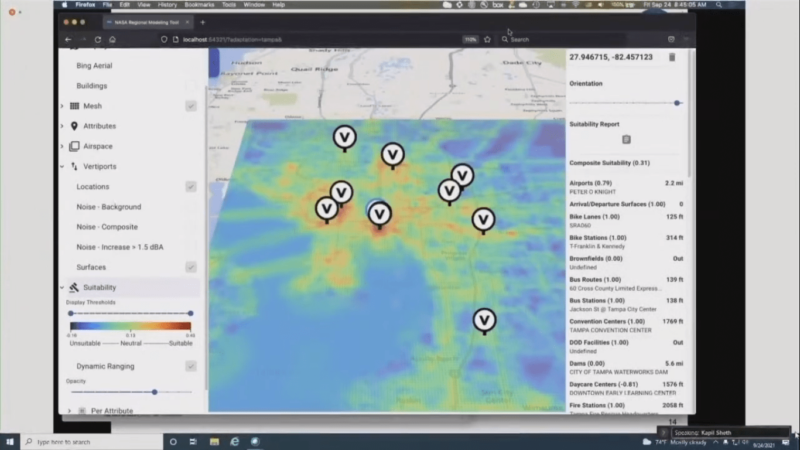Thrive
TBARTA, Hillsborough County partner with NASA on vertiport study

St. Pete Mayor Rick Kriseman’s announcement that he has engaged in talks with air taxi company Lilium was not the only news concerning this new method of transportation to come out of Friday’s Tampa Bay Area Regional Transit Authority (TBARTA) meeting.
Brian Pessaro, principal planner and project manager for TBARTA, closed the meeting with a presentation from NASA on its innovative model built to collect information and determine the feasibility of vertiports around Hillsborough County. Several factors and data points went into the regional suitability simulation to determine the best locations for launch and landing pads, which can be created on top of existing buildings and parking garages. Air taxis can also use existing helipads.
Pessaro told the board the collaboration with NASA is a result of a 2019 state grant that allocated $1 million for the study of innovative transit technologies. When the study was completed in July of 2020, Pessaro said one of the recommendations was for TBARTA to collaborate with NASA on the work the agency has been conducting on vertiports.
“It’s a planning tool,” said Pessaro. “In a nutshell, it creates a heatmap of a local area showing what locations are most and least suitable for vertiports.”
Pessaro said that since last December, TBARTA and the Hillsborough Transportation Planning Organization (TPO) have partnered with Dr. Kapil Sheth of the NASA Ames Research Center on customizing this geographic information system (GIS) model for Hillsborough County.
“I’m happy to report the work is 99.9% complete,” said Pessaro. “The Hillsborough TPO has taken ownership of the model, Dr. Sheth will be coming out in October to conduct some onsite training with the TPO’s GIS staff, and I need to point out that all of Dr. Sheth’s work on this was paid for by NASA.”
“What the TPO and TBARTA contributed was staff time and labor.”
Sheth, who has been with the NASA Ames Research Center for 25 years, then gave a presentation on how the model works in more detail. He said the program began a year and a half ago to determine what locations in downtown Los Angeles would be best suited to accommodate vertical take-off and landing (eVTOL) vehicles used in emissions-free jet and taxi service.
Sheth said research objectives included determining the safety and convenience, viability, infrastructure, scalability, traffic management and public acceptance of utilizing eVTOLs, although the Hillsborough study mostly focused on the potential infrastructure aspect.
Potential benefits of air taxis include increased mobility, shorter commutes and deliveries, decreased emissions and noise, and possibly less traffic congestion.
When adapting the regional modeling tool to discern vertiport suitability for Hillsborough County, Sheth said they looked at zoning parameters, possible environmental impacts, and how air taxis would interact with existing transit systems such as bus and train stations. Once those factors are established, Sheth said, they’re ranked according to their importance.
“Would you like to have some of these factors, such as fire stations, near your vertiport location?” asked Sheth rhetorically. “Or if it’s a power plant, you probably don’t want to be close to that.”
Once that data is collected, Sheth and his team “aggregate and threshold” the factors using algorithms to provide location suggestions.
“You can actually pinpoint a particular location and see what the data looks like,” said Sheth.
The software has an open architecture design, so municipalities can tailor and change the model to fit their specifications. Hillsborough County now has control of its model and is in that phase of the program.
Sheth showed the TBARTA the current heatmap for the county, with 11 potential vertiport locations pinpointed for further analysis. The most promising locations were concentrated in downtown Tampa and around Tampa International Airport. The model displays a 3-D rendering of buildings in the area, and clicking on a potential site will show its composite suitability score. One feature Sheth highlighted showed probable approach and departure paths and how the model shows any potential obstructions.
“It’s a data-driven model,” said Sheth. “It gives you an understanding of how good the location is. This is the first step in a preliminary analysis to see whether something like this would be beneficial to Hillsborough County.”
The model also serves as a simulation tool. The user can select vertiport locations, such as between Tampa and St. Pete, and then assess the feasibility of the flight. The simulation allows for different route structures, vehicle models, and even potential weather factors. It will then display information such as how long the trips would take.
Sheth said there are no minimum distance requirements, but the maxim distance, depending on which model eVTOL is used, is around 100-200 miles.
Pasco County Commissioner Kathryn Starkey said she “is excited for this new technology that is going to be here before we know it,” but “would like to do a more regional study for the area.”
“We’re (TBARTA) sitting on $8 million, this is one of our topics, why did this get handed over to Hillsborough County?” asked Starkey. “That’s a missed opportunity for us, and we’ve got to stop doing that.”
Pessaro reiterated that NASA paid for the program and added, “there’s no reason we couldn’t continue this effort in like a Phase 2 or Phase 3 with other counties within the TBARTA region that are interested in this tool.”








mick mccall
October 2, 2021at6:48 am
Electric VTOL aircraft won’t be silent nor non-polluting. Listen to the fan on your home air conditioning condenser unit beside your house. Now imagine the noise from the fan(s) needed to lift a two or three ton peoplebox a hundred feet OVER your house. Lacking nuclear power plants, windmills (want one in your backyard?), and room for solar farms to generate the extra power needed in Hillsborough county, electric airplanes will just move the hydrocarbon emissions to somebody else’s neighborhood. Other than that, having robotic drones carrying passengers over the neighborhoods is a great idea.
Rita Sewell
September 27, 2021at4:03 pm
Saw a NOVA recently on Electric Planes. Perhaps that might be the route to go. Quiet and non polluting.
https://www.forbes.com/sites/uhenergy/2021/07/12/time-to-clean-the-skies-electric-planes-have-arrived/?sh=b417805734a8